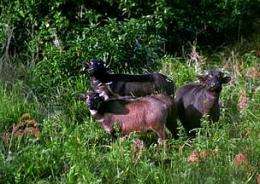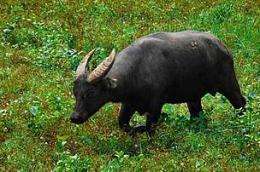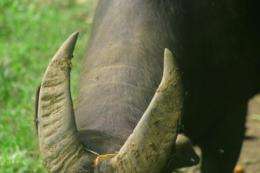World's rarest buffalo population reaches all-time high
Heavily-camouflaged by a sniper's Ghillie Suit and betrayed only by the scarlet glint of my field binoculars, I cautiously observe our quarry. A herd of tamaraw – emerging from a billowing field of cogon, not 50 meters away.
"We're within charging distance," warns our eagle-eyed tracker, Edgardo Flores. While hot, heavy and earthen-smelling, my leafy Ghillie Suit fools no one, as the buffalo herd stares right at us. Should they attack, Plan A was to scramble up the nearest tree. Plan B was well … we hoped Plan A would do.
Guided by spotters atop nearby Magawang Mountain, we took 30 minutes to approach this herd. Sloth-like, I exchange the binoculars for a telephoto, framing three buffalo forming a skirmish line, preparing to charge. As I click they bolt off, bounding back to the brush with more grace than any carabao can dream of.
I glance back at a smirking Ed. "Next group is behind that ridge. Maybe we'll get lucky."

Along with Ed are Maryo, Rudy and Henry. Our Tamaraw Conservation Programme (TCP) and World Wide Fund for Nature (WWF) recon squad has been sneaking up and down the grassy slopes of Occidental Mindoro's Iglit-Baco Mountain Range for the past two days. Our goal is to photograph the world's rarest and most endangered buffalo species, the tamaraw (Bubalus mindorensis) – less than 350 of which are thought to remain today.
I slink off my perch and silently follow Ed into the bush, thankful that neither Plan was put to use. Yet.
Locking Horns with Extinction
As the Philippines' largest and rarest endemic land animal, the tamaraw is a national icon. From coins to cars, provincial statues to university sports teams – this fierce little bovine has true star power.
Differentiated from the larger and more docile carabao (Bubalus bubalis carabanesis), the stocky tamaraw bears distinctive V-shaped horns, a shorter tail and a shaggy coat of chocolate to ebony fur. Adults stand four feet tall and average 300 kilograms – about half as much as a typical carabao.

Except for calving cows, adult tamaraw are mostly solitary. Cornered or threatened, they can be aggressive, chasing their foes for up to a kilometer. Hunters have long claimed to have emptied entire assault rifle clips into charging bulls, to no avail.
During the Pleistocene Epoch some 12,000 years back, tamaraw herds ranged across much of mainland Luzon. Extirpated by migrants, an estimated 10,000 heads remained on the island of Mindoro in the early 1900s.
Sadly, this last population has taken severe blows – ranging from a crippling outbreak of cattle-killing Rinderpest in the 1930s to incessant land clearing and poaching. It is thought that only a few hundred hold out atop the grassy slopes and forest patches of Mts. Iglit, Baco, Aruyan, Bongabong, Calavite and Halcon in Mindoro.
Today the tamaraw is classified by the International Union for the Conservation of Nature (IUCN) as critically endangered – the highest risk rating for any animal species. Four national laws protect it from poaching.
"Still some poachers come here to hunt them, mainly for sport," shares Ed as we trek warily to the next knoll, avoiding tall talahib stands which often conceal wily bulls. "Just this April we chanced upon a poaching laager. Our rangers recovered a tamaraw hide and assorted parts. Six hunters with tracker dogs snuck into the park at night, armed with M2 carbines, .22 hunting rifles and some homemade 12-gauge shotguns. Examples will be made – we're now filing for their arrest."
Under the Wildlife Act, violators can incur from six to 12 years of imprisonment plus a fine ranging from PHP100,000 (USD $2440) to PHP1M (USD $24,390).

Having served TCP as a ranger since 1998, Ed leads teams in patrolling core zones of the Iglit-Baco Park, which hosts such endangered (and darned hard to see!) species as the Philippine deer (Rusa marianna), Mindoro warty pig (Sus oliveri) and large Mindoro forest mouse (Apomys gracilirostris). It is also home to the reclusive, forest-dwelling Tawbuid or Batangan tribe, part of eight indigenous groups generally classified as 'Mangyan'. On our ascent, we encountered a 15-strong group gathering upland rice. As we tried to make contact, they bolted for a nearby grove of banana trees.
"Logging plus kaingin or slash-and-burn farming is also a major concern," adds Ed, explaining that many groups including the Tawbuid cut down the groves so essential for wildlife to thrive. Researching in Manila before the expedition, the future of the tamaraw seemed bleak – until I met TCP head and Mts. Iglit Baco Protected Area Superintendent Rodel Boyles in San Jose, Occidental Mindoro.
Tamaraw to Tribesfolk
"What's the best proof that what we're doing works?" asked a smiling Boyles at the TCP Headquarters a day before our expedition. "Well the tamaraw are still with us, aren't they? Community-based education is our drive. Some groups cannot read nor write, so it is our duty to let them know that certain animals are protected by law."
Since 1979, the Department of Environment and Natural Resources (DENR) has been working tirelessly through the TCP to manage and protect tamaraw core habitats, while engaging local communities to partake in conservation efforts. "We make it a point to hire Tawbuid tribesfolk not just as trackers or porters but as actual staff. Their bushcraft and knowledge of terrain make them particularly effective rangers," he adds.
The superintendent explains that their objective is to augment tamaraw numbers while improving the lives of the indigenous Tawbuid. "Our dream is to turn the park into the Mts. Iglit-Baco Biotic Area – a zone where the influence of modern society cannot replace the traditional practices of indigenous groups. We work not just to conserve the tamaraw – but the Tawbuid's way of life."
Provided by WWF